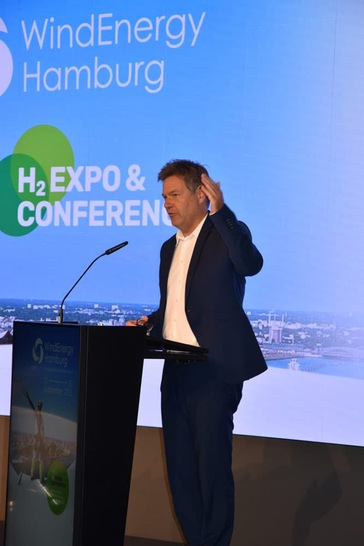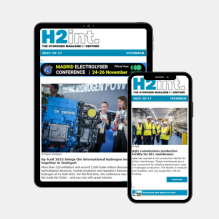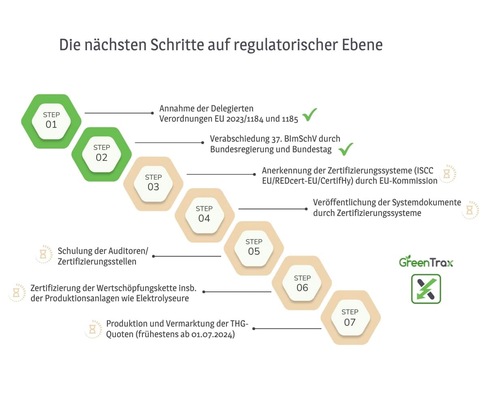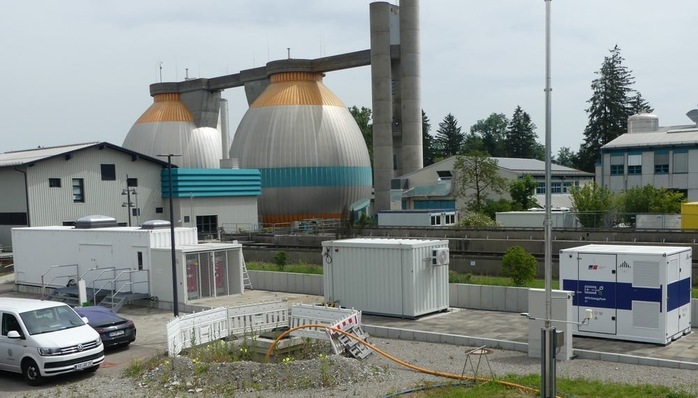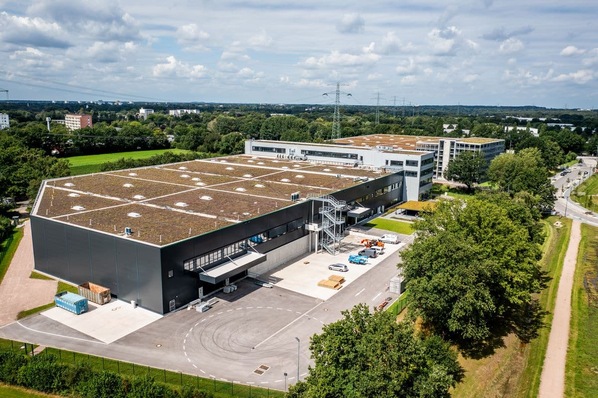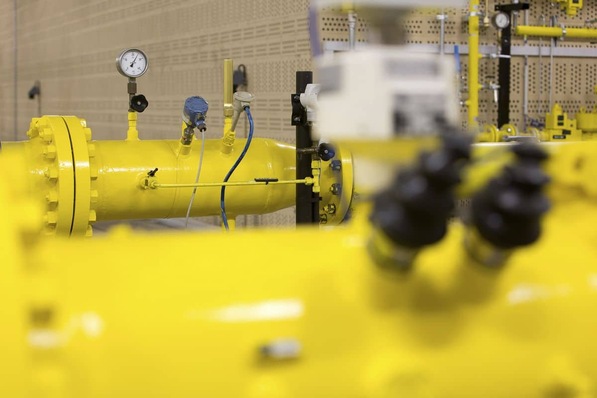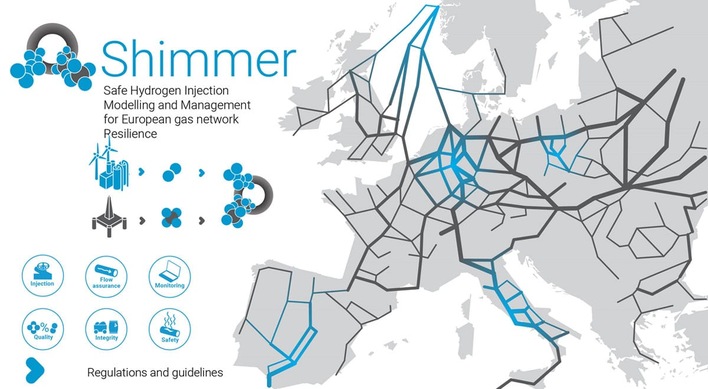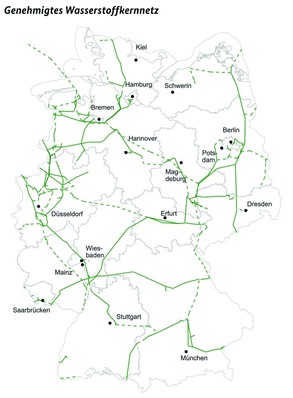Wind-derived hydrogen – it’s a term that’s been bandied about for years in the energy sector. In the past it was more of a blue-sky concept than a realistic prospect. Just a handful of demonstration projects were looking into the fundamental practicality of harnessing wind power for the purposes of hydrogen production. 2022 could well be the year that represents the start of the wind-hydrogen era. While relatively little has actually come to fruition, the plans for investment and construction are now so numerous and so definite that the arrival of wind-powered hydrogen production is virtually a foregone conclusion. This was certainly apparent at WindEnergy and H2Expo, which ran concurrently from September 27 to 30 in Hamburg.
After a four-year hiatus, the WindEnergy trade show was once again staged at Hamburg’s exhibition campus – live and in person. Due to the pandemic, the 2020 event was only available in an online format. Looking back, Bernd Aufderheide, president of Hamburg Messe und Congress, took stock of the much-altered political situation: “We are now living in a very different world.”
A total of around 30,000 visitors made the trip to Germany’s second-biggest city. The halls were well populated with roughly 1,400 exhibitors and the atmosphere was buzzing, particularly at the evening booth parties. It was therefore with fitting optimism that Aufderheide announced that the H2Expo & Conference will, from 2023, be a stand-alone trade fair – held jointly with WindEnergy only every two years.
“We need impetus and prospects to enable the rapid expansion of the wind and hydrogen economy. It’s time to put climate first.”
Bernd Aufderheide, board chairman at Hamburg Messe und Congress
Habeck opens WindEnergy
The star guest at the trade fair was German economy minister Robert Habeck who was invited to open the exhibition. That he chose to appear in person despite the then volatile political situation, with Germany’s coalition government embroiled in arguments over the country’s gas bill support scheme, speaks volumes about how much this sector means to him.
This was reflected in his keynote speech in which he emphasized the central role of both wind as an electricity generator and hydrogen as an energy carrier. He stated that he did not understand why some German states continue to hide behind a “10H” rule (which in local legislation dictates a large minimum gap between a wind turbine and residential buildings) and are not meeting the required expansion targets. Habeck said: “It’s not the time for business as usual. If the groundwork is not carried out, we will fail.”
He also took the opportunity to announce that Germany’s national hydrogen strategy would be revised before the year was up. What’s more, he indicated that the upswing was already underway, citing the approved IPCEI projects as an example. “The market will ramp up much more quickly than expected,” the minister declared.
Regional and international importance of H2Expo
The H2Expo & Conference, which according to Aufderheide was held in this form for the first time, saw 60 exhibitors gracing the floor in Hall A2 alone. At its center, organized as part of the hydrogen conference, was an extremely diverse program of presentations and podium discussions that ran across the four days of the event – available free of charge and accessible to all participants. That said, the exhibition entry fees were themselves relatively expensive, not that the pricing seemed a particular deterrent given the high number of attendees. The content covered a range of subjects including production, transportation and utilization of hydrogen on land and at sea as well as global value chains and the large-scale build-out of local infrastructure and guidelines on the harmonization of international standards. The limelight was shared by both regional and international projects.
For instance Aivars Starikovs, board chairman of the Latvian Hydrogen Association, had explained prior to the event: “Looking ahead, all three Baltic states are in a position to be key suppliers of green hydrogen for EU industry. Estonia, Latvia and Lithuania can, together, deliver 831 terawatt-hours of renewable power for the production of green hydrogen – that’s equivalent to at least 16 million metric tons a year.” However, he continued, this capacity can only be realized through close cooperation at a political and industrial level. Starikovs also underlined the significance of the city of Hamburg for the hydrogen economy: “The H2Expo & Conference is able to perform the important task of building bridges between Northern and Eastern Europe so that the economic and ecological challenges can be tackled jointly from a stronger position.”
National and international declarations
The wind sector used WindEnergy as a platform to make targeted demands aimed at politicians. In the Hamburg Declaration, leading associations from the wind industry (Global Wind Energy Councils, WindEurope, WindEnergie, VDMA Power Systems, Renewable Hydrogen Coalition) stated their position on the current energy and climate crisis and articulated their needs which, in their view, require energy policy decisions to be taken as a matter of urgency.
In addition, the North German Hydrogen Network signed an agreement on interregional collaboration to support the market ramp-up of the hydrogen industry and the implementation of northern Germany’s hydrogen strategy. Organizations involved in this were the Renewable Energy Hamburg cluster agency (EEHH), the Schleswig-Holstein Renewable Energy Network Agency (EE.SH) and the Mecklenburg-Vorpommern hydrogen energy cluster (WECMV) as well as the WindEnergy Network (WEN), the WAB business network and the Cuxhaven economic development agency (AfW).
What’s more, Hamburg and the Canadian province of Newfoundland and Labrador signed a declaration of intent that aims to foster cooperation at an international level. Both parties expressed their willingness “to share their experience and knowledge gained and to channel their expertise and strengths in a planned and coordinated way so as to build and develop a global, self-sustaining hydrogen economy.” Speaking to H2-international, Tom Rose, mayor of Stephenville in Newfoundland, appeared delighted and “extremely proud” that the agreement was ready to be signed in Hamburg after a preparatory period of just seven months.
H2Expo
The very first H2Expo was held back in 2001 in Hamburg (see fig. 2) under the direction of Ines Freesen and succeeded in filling an entire exhibition hall. However, the delayed market entry of some products meant that the event then switched to the congress center before disappearing completely. In future the H2Expo & Conference will again take place on an annual basis, running in parallel with WindEnergy every two years.
Author: Sven Geitmann


